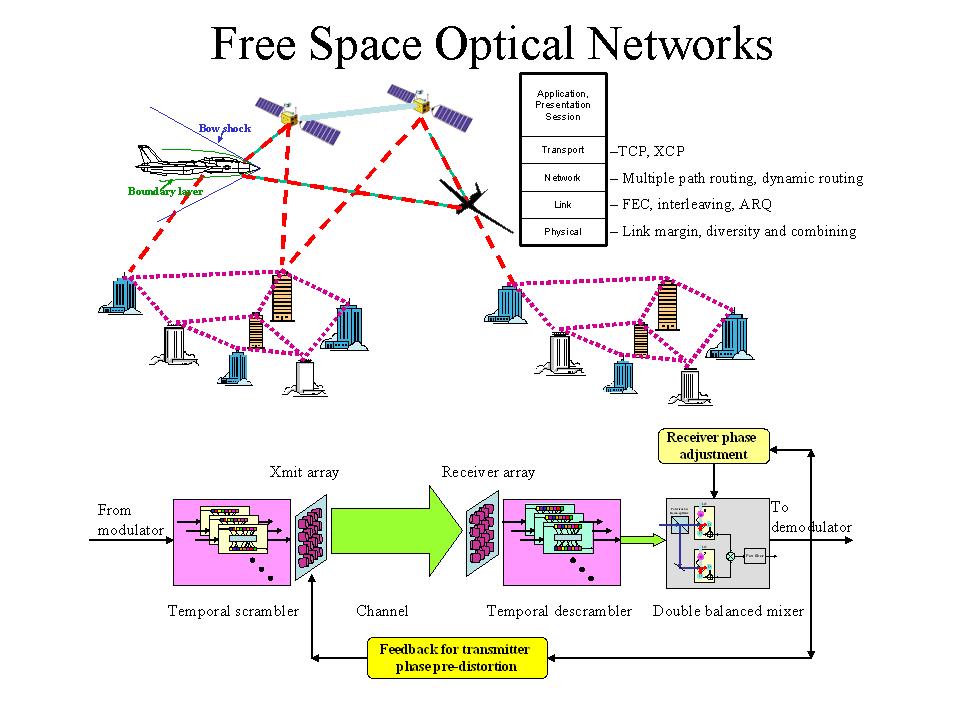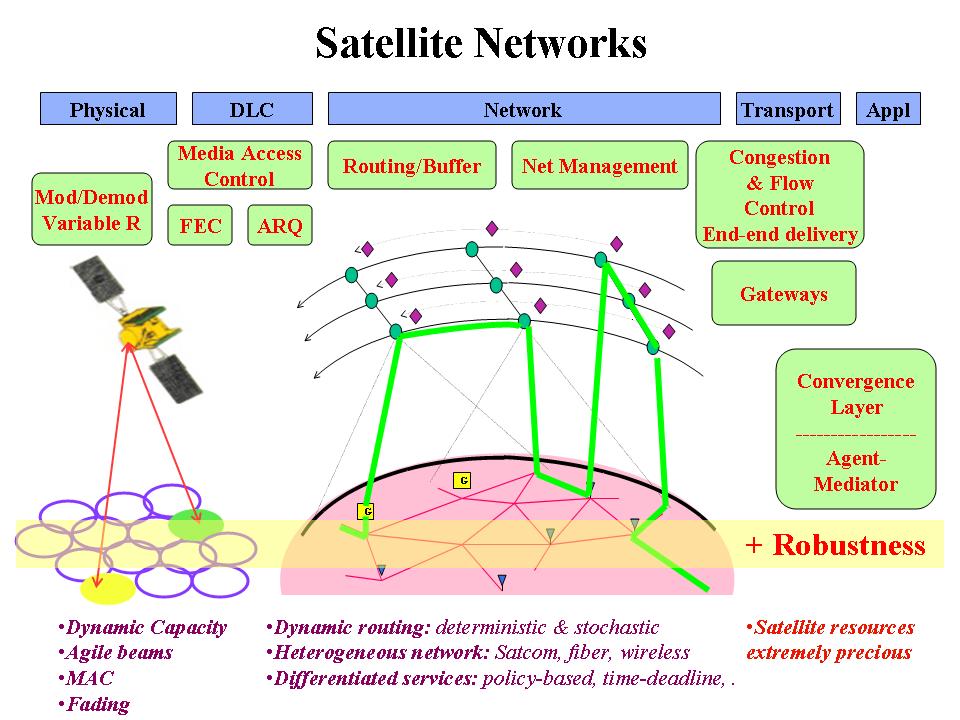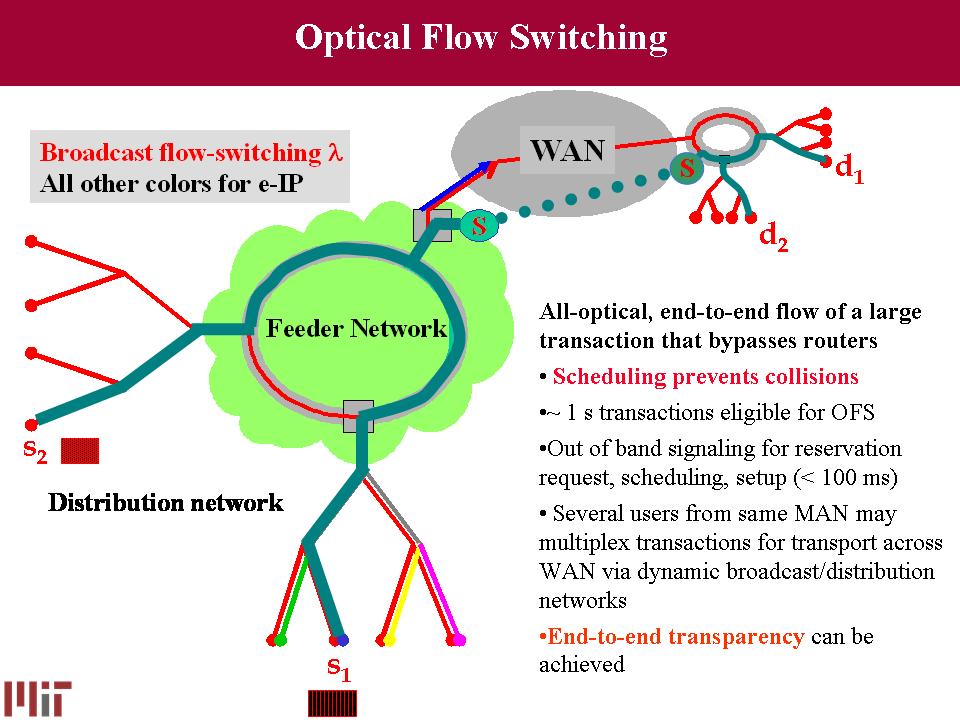RESEARCH PROJECTS Professor Vincent Chan has been actively involved in communication networks research projects with several organizations. Currently, he is the Principal Investigator for the following research projects and below are some brief descriptions of each project. |
 |
|---|
FREE SPACE OPTICAL NETWORKS Reliable free space coherent optical communication over the turbulent atmospheric channel Atmospheric optical communication over distances on the order of a kilometer allows the communication of data at modulation rates as high as hundreds of gigabits per second. However, the laser beams are susceptible to fading due to refractive index fluctuations induced by air-turbulence. Spatial diversity is an attractive technique to mitigate fades in the received signal. The focus of this research is to create a system architecture for reliable and survivable high data rate free space optical communications. The research can be divided into two major objectives: 1. Reliable free space coherent optical communication over the turbulent atmospheric channel 2. Survivable communication with low probability of detection, interception and denial of service via jamming by sophisticated adversaries with the best available technologies and knowledge of the system architecture The system techniques that address both objectives are related and the overall final architecture will integrate the two objectives in a single design. |
 |
SATELLITE NETWORKS This research project will address the architecture designs for efficient data communications over (satellite systems) and especially when they are interconnected with terrestrial fiber and wireless systems to form a heterogeneous global Internet. There are three main components to this research:
|

FUTURE OPTICAL NETWORK ARCHITECTURES
Our research objective is the creation of an optimized, heterogeneous optical network architecture, comprising current and future technology building blocks, that realizes the full potential of optical technology and that will be able to support exponentially increasing future bandwidth demands.
Our approach to developing an optimal optical network architecture will involve a restructuring and optimization of the existing network layer structure by: (i) treating architecture, protocols, and the physical layer as a single entity with strongly interacting, but distinct subsystems, and (ii) employing foreseeable technology as well as suggesting revolutionary hardware technology to exploit the benefits of optics wherever possible. The resulting intelligent optical network will be dynamically reconfigurable, and will enable various new applications by seamlessly optimizing network performance for all types of data traffic. Based on a system-wide optimization, the most efficient switching, routing and transport mechanisms will be developed, which we anticipate will include electronic packet switching as an important overlay atop a much higher-speed network. The enabling architectural concepts in our research are: (i) optical flow switching (OFS) and its implications on physical and higher layer architectures, and (ii) impairment aware routing.
PROACTIVE WIRELESS NETWORKS
The objective of this research is to develop a Proactive Mobile Wireless Network paradigm for next generation infrastructureless wireless networking to guarantee critical services to users with time deadline constraints. In contrast to existing mobile ad hoc wireless networks where frequent network disconnections and greatly degraded services may occur due to fluid changes in the location and composition of wireless devices in combat theatres, a proactive mobile wireless network actively maintains network connections to ensure continuous communication and timely delivery of mission-critical information. Such capabilities will be necessary and crucial for networks that operate under extreme operating scenarios, such as search and rescue.
The proposed Proactive Mobile Wireless Network architecture consists of the following primary components:
- User location, movement trajectory, and communication channel state estimation for network disconnection prediction.
- Adaptive deployment and movement command of helper nodes. These are additional wirelessly-enabled devices deployed with the single purpose of network connection maintenance. Examples of helper nodes include navigational robots or vehicles that plan their trajectories to connect user nodes where connections are most needed, or balloons and other aerial vehicles carrying communication relays that hover and drift above a region to provide wider communication coverage.
In the next phase of this project, we propose to: (1) improve the simulation environment to include physical obstacles and more realistic channel models to further assess the performance of the proposed network architecture; (2) develop distributed algorithms for network topology maintenance.
 |  |
|---|
Figure 1: Simulation of a 50 node proactive mobile wireless network with one helper node whose trajectory is controlled to provide network connectivity support. [1]
Figure 2: Expected number of helper nodes needed under different helper node deployment scenarios for a line network with randomly located user nodes. [2]
